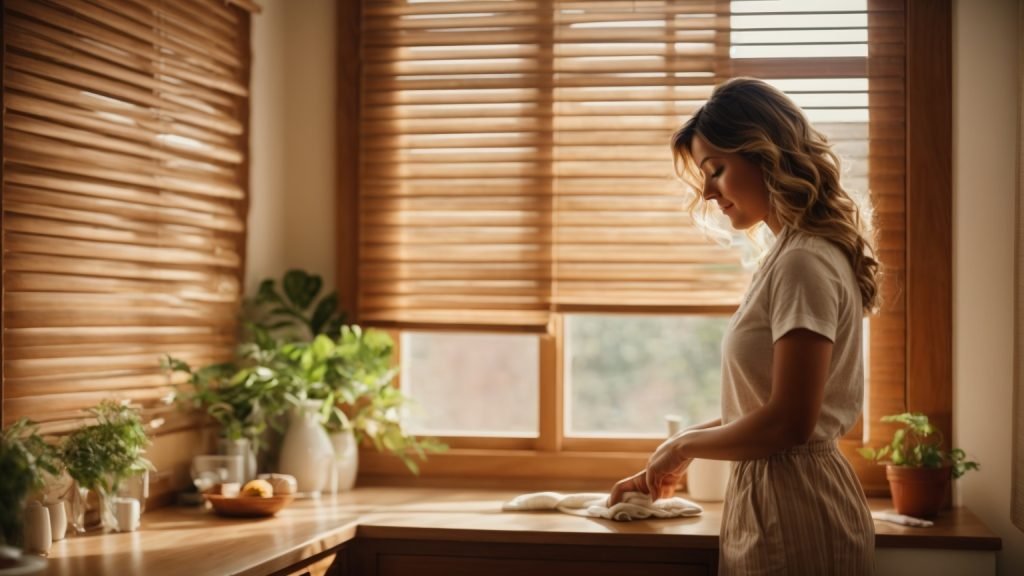Cleaning wooden blinds can be a daunting task, but it doesn’t have to be. With the right tools and techniques, you can have your blinds looking like new in no time. Whether you’re dealing with dust, grime, or stubborn stains, there are a variety of methods you can use to get your wooden blinds clean and looking great.
One of the most important things to keep in mind when cleaning wooden blinds is to avoid using harsh chemicals or abrasive materials that can damage the wood. Instead, opt for gentle cleaners and soft cloths or brushes that won’t scratch or scrape the surface of the blinds. Additionally, it’s important to take your time and be gentle when cleaning your blinds to avoid accidentally bending or breaking any of the slats.
There are a variety of methods you can use to clean wooden blinds, from dusting and vacuuming to more intensive deep cleaning techniques. Depending on the level of dirt and grime on your blinds, you may need to use a combination of methods to get them looking their best. So, let’s dive into some of the best ways to clean wooden blinds and get your windows looking sparkling clean.
Understanding the Type of Wood

When it comes to cleaning wooden blinds, it’s important to understand the type of wood they’re made of. Different types of wood require different cleaning methods to avoid damaging the material.
Hardwood vs. Softwood
Wooden blinds are typically made from either hardwood or softwood. Hardwood blinds are made from dense wood such as oak, cherry, or maple, while softwood blinds are made from lighter woods such as pine or cedar.
Stained vs. Painted
Another factor to consider is whether your wooden blinds are stained or painted. Stained blinds have a natural wood finish that allows the grain to show through, while painted blinds have a solid color finish.
Cleaning Tips
Here are some general tips for cleaning wooden blinds:
- Use a soft, clean cloth to dust your blinds regularly to prevent buildup.
- Avoid using water or harsh chemicals on your blinds, as this can damage the wood.
- For stained blinds, use a wood cleaner specifically designed for the type of wood your blinds are made from.
- For painted blinds, use a mild soap and water solution to gently clean the surface.
- Always dry your blinds thoroughly after cleaning to prevent warping or damage.
By understanding the type of wood your blinds are made of and using the proper cleaning methods, you can keep them looking great for years to come.
Choosing the Right Cleaning Supplies
Cleaning your wooden blinds can be a daunting task, but with the right cleaning supplies, it can be a breeze. Here are some tips to help you choose the right cleaning supplies for your wooden blinds.
Microfiber Cloth
A microfiber cloth is an excellent tool for cleaning wooden blinds. It is gentle on the wood and won’t scratch or damage the surface. Plus, it is reusable and can be washed and used again and again. When cleaning your wooden blinds, be sure to use a clean microfiber cloth to avoid spreading dust and dirt around.
Cleaning Solution
When it comes to choosing a cleaning solution, it’s essential to select one that is safe for your wooden blinds. Avoid using harsh chemicals or abrasive cleaners that can damage the wood. Instead, opt for a mild, non-acidic dish soap mixed with warm water. You can also use a specialized wood cleaner designed specifically for wooden blinds.
Vacuum Cleaner
A vacuum cleaner with an upholstery brush attachment can be a handy tool for cleaning wooden blinds. It can quickly remove dust and dirt from the surface of the blinds, making it easier to clean with a microfiber cloth or cleaning solution. Be sure to use the lowest setting on your vacuum cleaner to avoid damaging the wood.
Stepladder
A sturdy stepladder is necessary when cleaning wooden blinds that are out of reach. It’s essential to have a stable and secure platform to stand on to avoid accidents and injuries. When using a stepladder, be sure to follow safety guidelines and never stand on the top rung.
By choosing the right cleaning supplies, you can keep your wooden blinds looking clean and beautiful for years to come.
Pre-Cleaning Steps

Before you start cleaning your wooden blinds, it’s important to take some pre-cleaning steps to ensure that the cleaning process goes smoothly and effectively. Here are some steps you should take:
Dusting the Blinds
The first step in cleaning your wooden blinds is to dust them thoroughly. Use a soft-bristled brush or a microfiber cloth to gently sweep the dust off each slat. Make sure to dust both sides of the blinds, as well as the cords and the headrail.
If your blinds are particularly dusty, you can use a vacuum cleaner with a soft brush attachment to remove the dust. Simply run the brush attachment over each slat, making sure to get into all the crevices and corners.
Removing Stains
If your wooden blinds have stains or spots on them, you’ll need to remove them before you can start cleaning the blinds. Here are some tips for removing common stains:
- Water stains: If your blinds have water stains, you can remove them by rubbing the affected area with a soft cloth dipped in a mixture of equal parts white vinegar and water. Make sure to dry the area thoroughly afterwards.
- Grease stains: To remove grease stains, mix a small amount of dish soap with warm water and use a soft cloth to gently scrub the affected area. Rinse the area with clean water and dry thoroughly.
- Ink stains: Ink stains can be difficult to remove, but you can try using rubbing alcohol or nail polish remover to dissolve the ink. Apply a small amount of the solution to a clean cloth and gently rub the stain until it disappears.
By taking these pre-cleaning steps, you’ll be able to ensure that your wooden blinds are clean and looking their best.
Cleaning Process
Cleaning your wooden blinds is an essential task to keep them looking new and to prevent dust and dirt from building up. There are two primary methods for cleaning wooden blinds: wet cleaning and dry cleaning.
Wet Cleaning Method
To wet clean your wooden blinds, you will need a soft cloth, mild detergent or vinegar, and warm water. Follow these steps:
- Begin by closing the blinds and dusting them with a feather duster or microfiber cloth.
- Fill a bowl or bucket with warm water and add a small amount of mild detergent or vinegar.
- Dip the cloth into the solution and wring it out thoroughly.
- Starting from the top, wipe each slat with the damp cloth, using gentle pressure. Be careful not to scrub too hard, as this can damage the wood.
- Once you have cleaned all the slats, rinse the cloth in clean water and wring it out.
- Wipe each slat again with the damp cloth to remove any remaining soap residue.
- Finally, dry the blinds with a clean, dry cloth.
Dry Cleaning Method
To dry clean your wooden blinds, you can use a microfiber cloth or a feather duster. Follow these steps:
- Close the blinds and dust them with a microfiber cloth or a feather duster, starting from the top.
- If there are any stubborn spots or stains, use a soft-bristled brush to gently scrub them away.
- Once you have dusted all the slats, use a clean, dry cloth to wipe them down.
Remember to clean your wooden blinds regularly to keep them looking their best. Wet cleaning is recommended once or twice a year, while dry cleaning can be done as often as needed.
Post-Cleaning Care
After cleaning your wooden blinds, it is essential to take proper care of them to ensure their longevity. Here are some post-cleaning care tips that you can follow to keep your wooden blinds looking great for years to come.
Drying the Blinds
Once you have finished cleaning your wooden blinds, it is crucial to dry them thoroughly to prevent any water damage. Use a clean, dry cloth to wipe the blinds down, removing any excess water. Then, leave them open to air dry completely before closing them again.
Regular Maintenance Tips
To keep your wooden blinds looking their best, it is essential to perform regular maintenance. Here are some tips to help you maintain your wooden blinds:
- Dust your blinds regularly using a soft microfiber cloth or feather duster. This will help prevent dust buildup, which can cause discoloration and damage to the wood.
- Avoid using harsh chemicals or abrasive cleaners on your wooden blinds. Instead, use a mild soap and water solution to clean them.
- If you live in a dry climate, use a wood conditioner to keep your blinds moisturized and prevent cracking or warping.
- If you have pets, vacuum your blinds regularly with a soft upholstery brush attachment to remove any pet hair or dander.
By following these post-cleaning care tips and regular maintenance tips, you can keep your wooden blinds looking beautiful and extend their lifespan.
